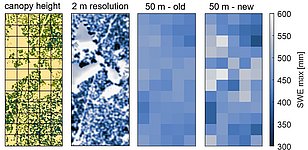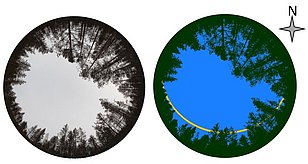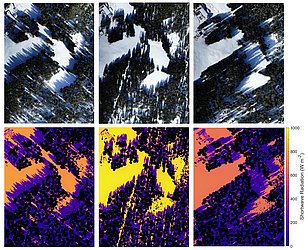Detailed knowledge of the snow cover evolution in forests is important for ecological, hydrological and climate modelling applications. The complex forest structure and its influence on snow accumulation and melt patterns make snow modelling in forests particularly challenging.
Measurements from our innovative observation platforms help us develop and improve our models, which aims at better representing forest structure control on snow accumulation and melt processes. One of the most important aspects in this representation is accurately capturing the complex radiation patterns at the snow surface.
Radiation modelling using hemispherical images and LiDAR ¶
Detailed forest structure information from hemispherical photographs and airborne laser scanning have allowed us to develop models for solar and thermal radiation. Hemispherical images can be used to calculate the blocking of solar radiation by the forest at fine time resolutions throughout the snow season at independent point locations within the forest. To apply these concepts over large areas for snowmelt modelling, we use lidar to reproduce this hemispherical view of the forest at in point on the snow surface. Using these methods, we can model both solar and thermal radiation at the snow surface at hundreds of thousands of locations across forested landscapes.
Forest snow modelling across spatial scales for hydrological and climate modelling applications ¶
Since radiation is the main driver of spatial snowmelt patterns, we have been able to greatly improve our snowmelt predictions in forests by integrating our radiation modelling approaches with a physics-based forest snow model. Our new model framework improved snow estimates at the scale of both individual trees and coarse resolutions of typical hydrological models (hundreds of metres). Our better radiation models also allow us to capture the patterns of canopy shadows on the snow surface, which is important due to its strong control on land surface albedo. Using these patterns, we are working on incorporating improved radiation modelling approaches into large-scale models. These models will increase our understanding of snow-albedo-climate feedbacks, with the ultimate goal of improving climate change predictions in snowy forest regions.



